Blog
May 20, 2016
Stories from the Land of the Long Grass
The Malilangwe Wildlife Reserve is set on 130,000 acres of pristine wilderness in southeastern Zimbabwe, bordering Gonarezhou National Park. It is a diverse and beautiful piece of Africa that is home to a healthy population of endangered black and white rhinos, as well as elephant and buffalo herds. There are also plenty of lions, cheetah, leopard, hyena and wild dogs to keep the herbivore population in check, and more than 400 different bird species. It is a wild and spectacular place that provides endless game spotting opportunities for our field guides and guests.
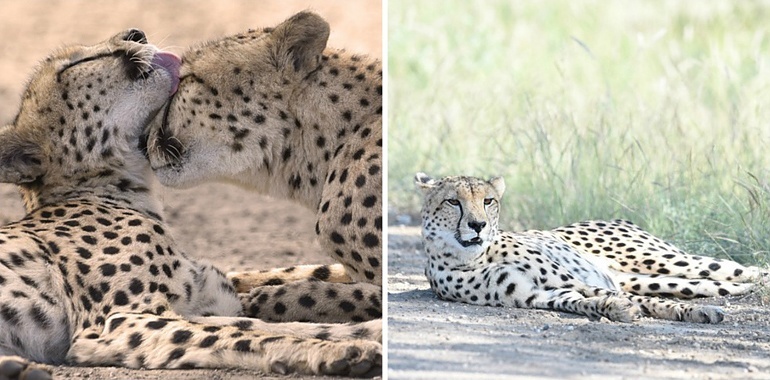
Perched above Lake Malilangwe, which is home to hippos, crocodiles, terrapins and monitor lizards as well as a variety of fish and water birds, is Singita Pamushana Lodge, the ecotourism arm of the reserve. Head Field Guide, Jenny Hishin, is responsible for putting together the monthly Wildlife Reports for the region; a task for which she is often spoiled for choice! Her latest dispatch is no exception – here are just some of the highlights:
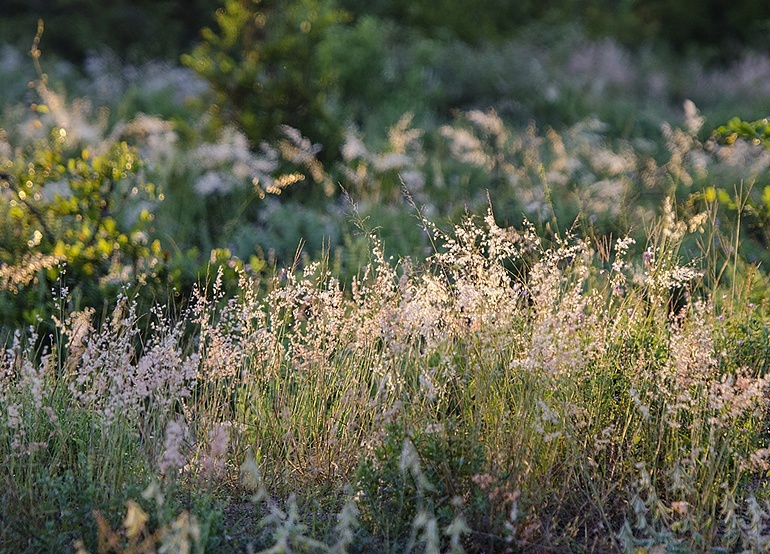
The grass is shoulder height at the moment, thanks to the rains in late March, and game viewing is at its most challenging. That said, there are still many spectacular sightings to see. There have been excellent cheetah sightings, including a coalition of two males, due to the shortage of open spaces with short grass (the cheetah’s preferred habitat). The tall grass also has its advantages for leopard viewing as these cats also prefer to move about on the roads at dusk and dawn, leading to one of our best ever months for logging leopard activity.
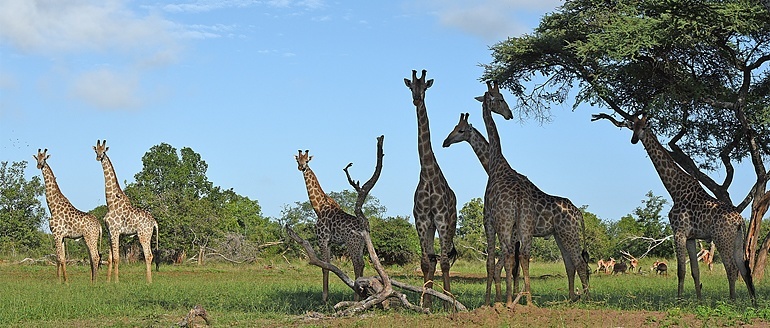
It’s hard work for lions to hunt at this time. The plains game are at their fittest and there’s plenty of surface water which means they can drink whenever and wherever they are – they are not forced to the permanent water sources where lions can lie in wait for their ‘meals’ to come to them. Before this kill, this particular pride were looking rather the worse for wear – very thin, angular and hungry. The heavy wake of vultures weighing down the surrounding tree branches led us to this scene where we found the pride feeding on a giraffe carcass. A giraffe is an enormous kill to make and a rare prey species, but with the long grass about it makes perfect sense to hunt them. Exactly how the lions caught this giraffe will remain a mystery, but they were making no bones about feasting on it! It looked like they couldn’t take another bite, and yet they kept at it, resting between feeding bouts and chasing off the presumptuous vultures.
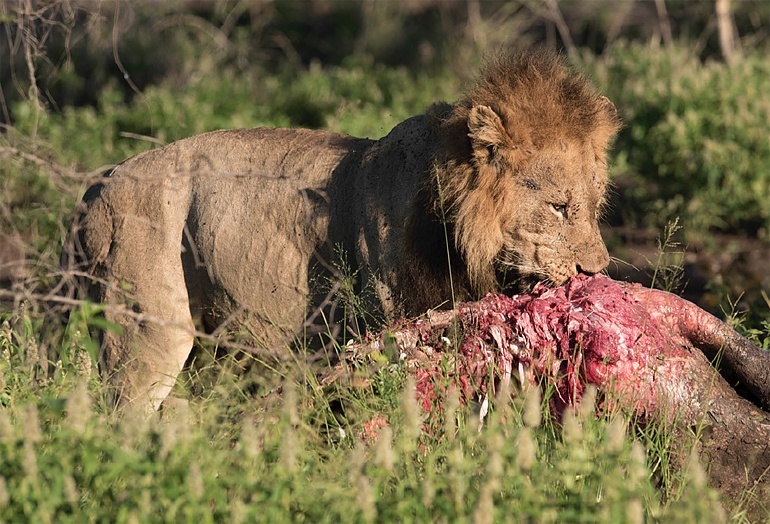
While the lions were enjoying their well-earned meal, the elephants have also been working their way through the abundant flora. Imagine having to eat 150 kg of grass a day, and then producing about 100 kg of dung! Elephants eat any plant material: grass, forbs, leaves, branches, bark, roots, fruit, seeds, pods, wood, reeds, sedges – you name it, they eat it, even commercial crops! At the moment their diet is about 98% grass and they are reaping huge trunk-fulls of it while chewing the previous mouthful as you can see in these photos.

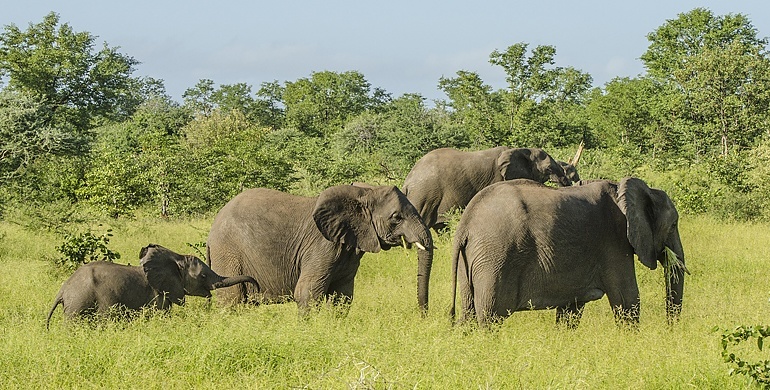
Singita Pamushana Lodge is managed by Singita on behalf of The Malilangwe Trust, a non-profit sustainable tourism initiative, and all proceeds from the lodge benefit the Trust’s numerous conservation and community programmes in the area. To find out more about our Conservation work in this incredible part of Zimbabwe, please visit our website.
The post Stories from the Land of the Long Grass appeared first on Singita.





































Add comment
The Malilangwe Wildlife Reserve is set on 130,000 acres of pristine wilderness in southeastern Zimbabwe, bordering Gonarezhou National Park. It is a diverse and beautiful piece of Africa that is home to a healthy population of endangered black and white rhinos, as well as elephant and buffalo herds. There are also plenty of lions, cheetah, leopard, hyena and wild dogs to keep the herbivore population in check, and more than 400 different bird species. It is a wild and spectacular place that provides endless game spotting opportunities for our field guides and guests.
Perched above Lake Malilangwe, which is home to hippos, crocodiles, terrapins and monitor lizards as well as a variety of fish and water birds, is Singita Pamushana Lodge, the ecotourism arm of the reserve. Head Field Guide, Jenny Hishin, is responsible for putting together the monthly Wildlife Reports for the region; a task for which she is often spoiled for choice! Her latest dispatch is no exception – here are just some of the highlights:
The grass is shoulder height at the moment, thanks to the rains in late March, and game viewing is at its most challenging. That said, there are still many spectacular sightings to see. There have been excellent cheetah sightings, including a coalition of two males, due to the shortage of open spaces with short grass (the cheetah’s preferred habitat). The tall grass also has its advantages for leopard viewing as these cats also prefer to move about on the roads at dusk and dawn, leading to one of our best ever months for logging leopard activity.
It’s hard work for lions to hunt at this time. The plains game are at their fittest and there’s plenty of surface water which means they can drink whenever and wherever they are – they are not forced to the permanent water sources where lions can lie in wait for their ‘meals’ to come to them. Before this kill, this particular pride were looking rather the worse for wear – very thin, angular and hungry. The heavy wake of vultures weighing down the surrounding tree branches led us to this scene where we found the pride feeding on a giraffe carcass. A giraffe is an enormous kill to make and a rare prey species, but with the long grass about it makes perfect sense to hunt them. Exactly how the lions caught this giraffe will remain a mystery, but they were making no bones about feasting on it! It looked like they couldn’t take another bite, and yet they kept at it, resting between feeding bouts and chasing off the presumptuous vultures.
While the lions were enjoying their well-earned meal, the elephants have also been working their way through the abundant flora. Imagine having to eat 150 kg of grass a day, and then producing about 100 kg of dung! Elephants eat any plant material: grass, forbs, leaves, branches, bark, roots, fruit, seeds, pods, wood, reeds, sedges – you name it, they eat it, even commercial crops! At the moment their diet is about 98% grass and they are reaping huge trunk-fulls of it while chewing the previous mouthful as you can see in these photos.
Singita Pamushana Lodge is managed by Singita on behalf of The Malilangwe Trust, a non-profit sustainable tourism initiative, and all proceeds from the lodge benefit the Trust’s numerous conservation and community programmes in the area. To find out more about our Conservation work in this incredible part of Zimbabwe, please visit our website.
The post Stories from the Land of the Long Grass appeared first on Singita.